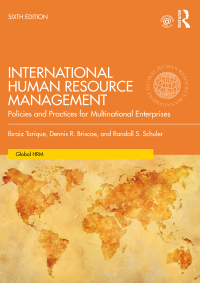Lance Richards, former international director of HR at Teleglobe, has been through a number of major cross-border
Question:
Lance Richards, former international director of HR at Teleglobe, has been through a number of major cross-border acquisitions and alliances. These included British Telecom with MCI and GTE with Bell Atlantic, and then with Teleglobe and BCE. These experiences have taught Lance that in any cross-border acquisition or alliance, making sure that employees know what is going on, who is in charge, and where the combined organization is heading needs to be in the very front of any HR initiatives. Some of the specific lessons for guaranteeing success in an acquisition that Lance has learned include:
• The CEOs (of both the acquiring and the acquired firms) must be visible to the employees and must continuously interact with them.
• Both companies must communicate clearly, constantly, and quickly.
• The dialogue with employees must be two-way. Employees must have a way to feed questions and concerns back to the business and people in charge, and then to get answers.
As Lance puts it, in many acquisitions and alliances, the corporate heads roll out a well-crafted vision of the new entity, how it will lead the market, and how it will now be able to leap ahead of its competitors. But for the average employee, all they want to hear is what is going to happen to their particular jobs. In M&A activity, where the intellectual capital that resides in the employees is often (or should be) the overriding concern, it is important, at the end of the day, to remember that employees are concerned about things like making their next car payments or paying the next term’s tuition for their child.
The BCE acquisition of Teleglobe (completed in November 1, 2000) provided a great example of how to handle employee expectations and concerns with professionalism and candor. BCE Inc. is the largest communications company in Canada and provides a variety of services such as broadband communications and content services to private and public customers. Simultaneously with the aftermarket-hours announcement to the public, all employees received an e-mail with a link to a pre-recorded streaming video, with messages from the chairmen of both firms. They clearly outlined the reasons for the acquisition, as well as the benefits, and then committed to maintain clear communications throughout the process of merging the two firms.
A Q&A board was established on the companies’ intranets, accessible in all 43 countries where the firms had employees, with a promise to answer most questions within five business days. Within a month, BCE had appointed a new CEO. Within a week of his arrival, he held the first of several meetings with employees. Initially, he made presentations in person in all of the firms’ primary employment cities, then changed to a live, multi-country broadcast format, followed by conference calls for outlying countries. Simultaneously, he launched a series of breakfast and lunch meetings with fifteen to twenty employees, which continued for months, wherever his travels took him. In consequence, the new CEO won much favor with employees for his candor and style. The key was that Teleglobe International (and BCE) immediately opened a variety of one- and two-way communication venues for all employees and ensured that there was a steady flow of information to everyone. Even though major financial problems with the acquisition led to divestiture of Teleglobe after about two years, the strong employee communications did result in quite limited voluntary employee turnover and led to strong engagement from employees, leading to a continuing healthy BCE. Teleglobe has gone through several acquisitions since then and is now part of Tata Communications Group (an Indian MNE headquartered in Mumbai, India).
Case study questions
1. Why were these various forms of communication so successful? Which do you think were most important? Why? Which barriers stand in the way of using these forms of communication?
2. What content is necessary for this form of communication? What do employees need (want) to hear? What difference does it make?
3. Does this sort of communication need to come from the top? Can someone else, such as the head of HR, provide the information with equal success?
Step by Step Answer:

International Human Resource Management Policies And Practices For Multinational Enterprises
ISBN: 9781138489493,9780429806124
6th Edition
Authors: Ibraiz Tarique , Dennis R. Briscoe , Randall S. Schuler





